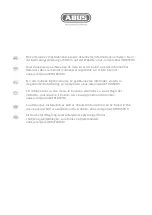
49
S:\Hp8960\E1960A GSM Mobile Test Application\A.04 Release\Reference_Manual\Chapters\meas_ber_desc.fm
Bit Error Measurement Description
If necessary, the user may manually set the delay (see
“SETup:BERRor:LDControl:AUTO” on page 388
).
NOTE
In case the test set is not able to correlate the data it transmits on the downlink with the data it
receives on the uplink, a Measurement Timeout value should be set. If a timeout is not set and
the test set is unable to correlate, the measurement will appear to “hang”.
The BER measurement trigger source is always set to immediate. The BER measurement does not offer
multi-measurement results. See
“Statistical Measurement Results” on page 136
BER, FBER, and DAUDIO (uplink speech level) measurements are mutually exclusive measurements.
Whichever of these measurements is activated last forces the others to become inactive.
Measurements type
Residual:
• Residual Type IA (50 bits per speech frame)
• Residual Type IB (132 bits per speech frame)
• Residual Type II (78 bits per speech frame)
Loopback Type A is sent to the mobile station when one of these residual measurement types is selected. A
BER measurement with FE will return the frame erasure count or ratio results. The mobile station will
indicate in the speech frame, if the downlink frame was received with CRC (cyclic redundancy check) errors
the speech frames are erased. The mobile station sets all bits in the uplink speech frame to 0, indicating
speech frames were erased.
Non-residual:
• Type IA (50 bits per speech frame)
• Type IB (132 bits per speech frame)
• Type II (78 bits per speech frame)
Loopback Type B is sent to the mobile station when one of these non-residual measurement types is selected.
A BER measurement with CRC’s (cyclic redundancy check) will return the CRC count or ratio results. The
mobile station will not indicate if any speech frames in the downlink were erased.
BER measurement results
The results of a BER measurement can be displayed in two ways, (number of errors counted) or (the ratio bad
bits (errors) to total bits counted). The manual user will need to select either Count or % from the
Measurement Units field. For the remote user these results are available by using the FETCh command, see
“FETCh:BERRor:COUNt[:BITS]?” on page 303
“FETCh:BERRor:RATio[:BITS]?” on page 306
. Alternatively
the
“FETCh:BERRor[:ALL]?” on page 302
“FETCh:BERRor:FULL?” on page 305
can also be used to return
the results.
Summary of Contents for 8960 Series 10
Page 26: ...26 Contents ...
















































